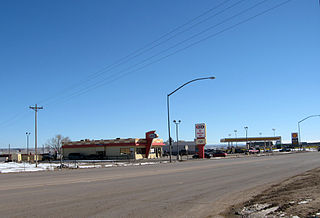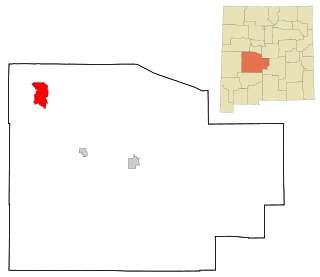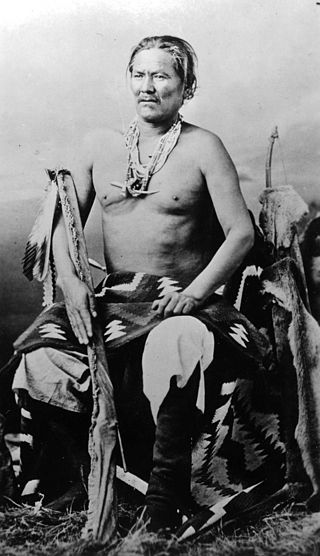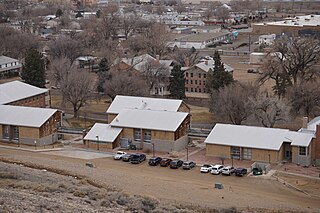
Chinle is a census-designated place (CDP) in Apache County, Arizona, United States. The name in Navajo means "flowing out" and is a reference to the location where the water flows out of the Canyon de Chelly. The population was 4,518 at the 2010 census.

Window Rock, known in Navajo as Tségháhoodzání, is a census-designated place (CDP) that serves as the seat of government and capital of the Navajo Nation, the largest territory in North America of a sovereign Native American nation. The capital lies within the boundaries of the St. Michaels Chapter, adjacent to the Arizona and New Mexico state line. Window Rock is the site of the Navajo Nation governmental campus, which contains the Navajo Nation Council, Navajo Nation Supreme Court, the offices of the Navajo Nation President and Vice President, and many Navajo government buildings.

Alamo is a census-designated place (CDP) in Socorro County, New Mexico, United States. The population was 1,085 at the 2010 census. It is the largest community on the Alamo Navajo Indian Reservation.

Diné College is a public tribal land-grant college based in Tsaile, Arizona, serving the 27,000-square-mile (70,000 km2) Navajo Nation. It offers associate degrees, bachelor's degrees, and academic certificates.

The Navajo are a Native American people of the Southwestern United States.
Many Farms High School (MFHS) is located in the heart of the Navajo reservation in Many Farms, Arizona, and 15 miles (24 km) northeast of Canyon De Chelly National Monument. It has 445 students and 35 faculty members along with a large support staff. It is a boarding school operated by the US Department of the Interior Bureau of Indian Education, with separate dormitories for male and female students. It opened its doors in 1969.

The Ramah Navajo Indian Reservation is a non-contiguous section of the Navajo Nation lying in parts of west-central Cibola and southern McKinley counties in New Mexico, United States, just east and southeast of the Zuni Indian Reservation. It has a land area of 230.675 sq mi (597.445 km²), over 95 percent of which is designated as off-reservation trust land. According to the 2000 census, the resident population is 2,167 persons. The Ramah Reservation's land area is less than one percent of the Navajo Nation's total area.
Gallup-McKinley County Schools (GMCS) is a school district based in Gallup, New Mexico which serves students from Gallup and surrounding areas of McKinley County.

Navajo Preparatory School is a college preparatory school located in Farmington, New Mexico. The school is fully sanctioned by the Navajo Nation since 1991 when the previous Navajo Academy closed due to lack of funding. The campus is currently undergoing a remodelling project for the past few years that includes new dormitories, classrooms, and an athletic sports complex. The school colors are black, turquoise, yellow, and white which represent the four seasons in Navajo Culture and the mascot is the eagle. The previous school colors for Navajo Mission and Navajo Academy were red, white, and blue. In 2021- 2022 school year, the school color will go back to red, white, and blue.

The Bureau of Indian Education (BIE), headquartered in the Main Interior Building in Washington, D.C., and formerly known as the Office of Indian Education Programs (OIEP), is a division of the U.S. Department of the Interior under the Assistant Secretary for Indian Affairs. It is responsible for the line direction and management of all BIE education functions, including the formation of policies and procedures, the supervision of all program activities, and the approval of the expenditure of funds appropriated for BIE education functions.
Greyhills Academy High School is a Native American boarding high school in Tuba City, Arizona on the Navajo Nation. It is operated by the Western Navajo Agency, a tribal agency working in affiliation with the Bureau of Indian Education (BIE), which funds the school.
Rock Point Community School is a school in Rock Point, Arizona. It is directly operated by the Bureau of Indian Education (BIE). It employs some 90–100 faculty members. It is split into elementary (K–6) and secondary (7–12) units which is overlooked by a Chief Executive Officer and their own principals. It offers fully bilingual English and Navajo language education.

Ádahooníłígíí was a Navajo-language monthly newspaper that was published in the Southwestern United States from 1943 to 1957. After the Cherokee Phoenix, operating from 1828 to 1834, it was the second regularly circulating newspaper in the United States that was written in a Native American language. It was the first newspaper to be published in Navajo and the only one to have been written entirely in Navajo. In April 2019, roughly 100 issues of the newspaper were digitized as a part of the University of Arizona Library's National Digital Newspaper Program and they are currently available online.

Charles Monty Roessel is a Navajo (Diné) photographer, journalist and academic administrator. Roessel served as Director of the Bureau of Indian Education from 2013 until 2016. He currently serves as the president of Diné College.

Many Farms Community School, Inc. (MFCS), is a tribally controlled K-8 school in Many Farms, Arizona, operated by the Navajo Nation. It is funded by the Bureau of Indian Education (BIE). MFCS has a boarding program to serve students who live at a distance from this community.
Pine Hill Schools is a K-12 tribal school system operated by the Ramah Navajo School Board, Inc. (RNSB), in association with the Bureau of Indian Education (BIE), in Pine Hill, New Mexico.

Tuba City Boarding School (TCBS) is a Bureau of Indian Education (BIE)-operated DK-8 boarding school in Tuba City, Arizona.
Sam Ahkeah was a former Navajo Nation Chairman. He was elected as the 7th chairman of the Navajo Nation Tribal Council. He served in office from 1946 through 1954 and was elected to serve for two terms. Ahkeah served as an overseer for the Mesa Verde National Park. During his time in office, Chairman Ahkeah met with the United States Congress to discuss the Colorado River Storage Project. Ahkeah advocated for the Colorado River Storage Project because it would benefit the Navajo Nation.














